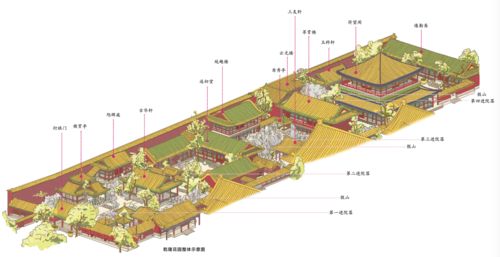
The Imperial Garden: An Oasis of Serenity in the Forbidden City
Leaving the Kuninggong Palace through its rear gate, Kuningmen, you enter a realm dedicated to health and well-being. Here, within the confines of the Forbidden City, lay the quarters of the imperial physicians. Their consulting rooms and dispensaries, brimming with herbs and remedies, stood ready to address any ailment that might befall the imperial family. Nearby, chambers housed the eunuchs, the emperors' castrated servants, who played an integral role in the palace's daily operations.
But this area held more than just practical functions; it served as a gateway to tranquility—the entrance to the Imperial Garden.
A Garden of Imperial Leisure and Ritual
Established in 1417 and meticulously preserved throughout the centuries, the Imperial Garden stands as a testament to the enduring beauty of Chinese landscape design. This verdant sanctuary served as a place of respite and recreation for the emperors, empresses, and consorts who resided within the Forbidden City's walls. Yet, its purpose extended beyond mere leisure. The Imperial Garden also provided a serene setting for important rituals and ceremonies, connecting the imperial court with the natural world and the heavens.
A Stroll Through Time: Experiencing the Garden's Splendor
Stepping into the Imperial Garden is akin to stepping back in time. It remains one of the few surviving gardens designed in the elegant style of traditional Chinese landscaping. Towering, ancient cypress trees provide a canopy of green, framing picturesque views of pavilions, bridges, and winding pathways.
The garden's rectangular layout encompasses roughly 12,000 square meters, an area smaller than Tiananmen Square yet teeming with intricate details. Within this space, approximately twenty structures of diverse styles dot the landscape, each harmoniously integrated with natural elements. Lush rockeries adorned with blooming flowers, carefully pruned trees, and ornate bronze incense burners create a symphony of sights and scents, inviting contemplation and quiet reflection.
The Hall of Imperial Peace: A Symbol of Harmony and Protection
At the heart of the Imperial Garden lies the grand Tai Ping Dian (Hall of Imperial Peace), the largest structure within the garden. Constructed around the year 1400, this impressive hall, encircled by a protective wall, embodies the garden's significance as a place of balance and harmony.
Facing the Tai Ping Dian stands a testament to time—a magnificent pine tree known as the "Concubine Pine." With a history spanning over four centuries, this ancient tree symbolizes the enduring harmony between the emperor and empress. Guarding the entrance to the hall, a pair of gilded unicorns stand sentinel. These mythical creatures, believed to ward off evil spirits, highlight the spiritual importance imbued within the garden's design.
The Tai Ping Dian itself served as a place of reverence for the Taoist deity Zhenwu, the God of Water. Here, amidst the garden's serenity, prayers were offered to Zhenwu, seeking his divine protection against the ever-present threat of fire within the palace walls.
The Four Seasons Represented: Pavilions Marking Time's Passage
Four exquisite pavilions, each strategically positioned at a corner of the garden, serve as elegant markers of time's passage. These structures, unique in their architectural styles, symbolize the cyclical nature of the four seasons.
The most renowned of these pavilions, the Wanchun Ting (Pavilion of Ten Thousand Springs), graces the eastern corner. Constructed in 1535 and meticulously restored during the Qing dynasty, the Wanchun Ting embodies the renewal and vitality associated with springtime.
The Mountain of Gathering Beauty: An Imperial Vantage Point
Rising from the garden's landscape, the artificial hill known as "Dui Xiou Shan" (Mountain of Gathering Beauty) offers a commanding view of the surroundings. This miniature mountain, embedded with grottoes and adorned with carefully placed rocks, culminates in the "Yu Guan Ting" (Pavilion of Imperial View). From this elevated vantage point, emperors, accompanied by their families, would gather during the Double Ninth Festival to observe the grand celebrations unfolding below.
Paths of Fortune: Strolling on Auspicious Ground
As you meander through the Imperial Garden, take note of the pathways beneath your feet. These are not merely paths of stone but intricate mosaics, each paved with pebbles of various colors. These colorful stones, particularly the use of smooth, oval-shaped pebbles known as "goose egg stones," are not merely decorative but imbued with symbolic meaning. They represent good fortune, a subtle yet powerful reminder of the auspicious nature of the Imperial Garden.
Q&A
Q: What is the significance of the Imperial Garden's location within the Forbidden City?
A: Situated behind the Kuninggong Palace, the Imperial Garden provided a secluded and serene escape for the imperial family from the formalities and pressures of court life.
Q: How does the Imperial Garden reflect traditional Chinese beliefs?
A: The garden's design embodies key principles of Chinese cosmology and philosophy. The arrangement of buildings, plants, and water elements reflects the harmonious balance between nature and human intervention, a concept central to Chinese thought.
Q: Why was the Tai Ping Dian an important structure within the Imperial Garden?
A: The Tai Ping Dian served not only as a grand hall but also as a spiritual center within the garden. The prayers offered there to Zhenwu, the God of Water, underscore the importance placed on protection from fire within the largely wooden structures of the Forbidden City.